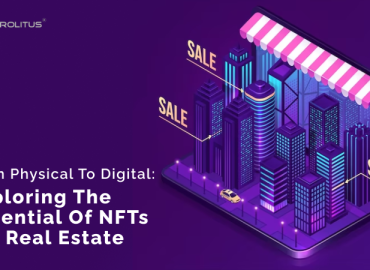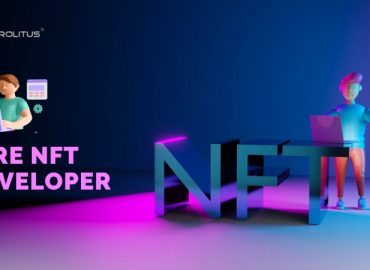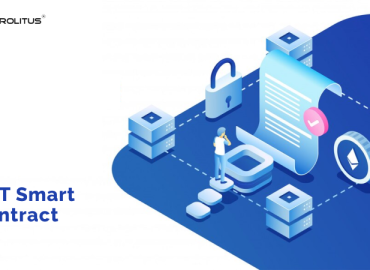Blockchain and digital assets have received a lot of attention as of late. People, organizations, and governments must do everything they can to prepare for the digital economy. As a result, you can’t possibly have learned about blockchain without hearing about tokens.
Several academics have highlighted the potential of NFTs to shape the future of blockchain. Therefore, they have been receiving a lot of attention from users and enthusiasts worldwide.
A non-fungible token (NFT) is a token that uses blockchain technology to provide a unique connection to a non-replicable digital asset. In contrast to other prominent cryptocurrencies like Bitcoin, Ether, and Monero, NFT cannot be exchanged for tokens of equal value. Hence, NFTs have their individual properties; therefore, they can’t be swapped out for another token of the same type.
The data that sets NFTs apart from other tokens can be securely stored inside the tokens thanks to the smart contracts included within them. A distinguishing feature of NFTs is their indivisibility. Unlike Bitcoin, sending a lower amount of a non-fungible token is impossible. That means you can’t split an NFT and send it to someone else in parts.
Therefore, due to their specific nature, non-fungible tokens play a particular function in the current blockchain ecosystem. Most importantly, NFTs have greater significance in the context of the drastic change toward the next phase of blockchain digital transformation. NFTs have the potential to revolutionize the business world as more and more companies warm up to the idea of blockchain and begin incorporating blockchain technology into their operations.
The most common use cases for NFTs?
- The ownership of digital assets such as art, music, or videos can be represented by NFTs if the user chooses. The fundamental concept is that NFTs can be used to vouch that a particular digital item is an original version and that the creator has confirmed its authenticity. This would assist in lowering the rate of piracy and ensure that creators are reimbursed fairly for their work.
- NFTs also have the potential to be utilized in the development of decentralized marketplaces. For example, a non-fungible token (NFT) can stand in for a particular piece of virtual real estate in a virtual environment. If you purchased an NFT, you would become the owner of that piece of property and would have the right to either sell it or rent it out to other people who might be interested in using it.
- Loyalty points and awards are another fascinating use case for non-fungible tokens. For instance, a corporation might choose to issue NFTs that can later be exchanged for price reductions or other enticements. This would incentivize customers to continue using the products or services provided by the corporation.
- NFTs can also be utilized in the production of digital collectibles. For instance, a game might hand out NFTs representing unique in-game objects. Collectors would pay a high price for these NFTs because of their desirability, which would be tradable on secondary markets.
- NFTs have the potential to serve as a representation of ownership interest in underlying physical assets. As an illustration, a car manufacturer might issue NFTs that reflect ownership of an automobile’s specific model. The non-fungible token (NFT) would be saved on a blockchain and could be transferred to a new owner if the vehicle was sold.
- NFTs have the potential to function as utility tokens. An example would be if an NFT were to represent a key to unlock access to a particular piece of content or service. This would open up new avenues for content providers to generate revenue.
- Applications in gaming can benefit from the use of NFTs. An NFT might, for instance, stand in for a particular player character in a video game. If the original owner of the NFT decided to sell it, the ownership could be transferred to another player, and the NFT would be recorded on a blockchain.
- NFTs can help represent carbon credit ownership by using NFTs if desired. This would result in establishing a carbon credit market and contribute to reducing emissions produced by enterprises and individuals.
Prominent NFT-based applications
Metaverse
Metaverse is projected to touch practically every business, and its market value is expected to reach a trillion dollars in the future. However, given that this is a developing field of study, a precise time frame for the technology’s mainstream adoption is difficult to establish.
Real State
NFTs serve as the medium for the exchange of virtual real estate. When a piece of digital real estate is sold, the NFT token representing that piece of land is moved from the seller’s wallet to the buyer’s. Republic Realm made the largest metaverse land purchase in the Sandbox, one of the virtual worlds, for $4.3 million. Gucci, PwC, Samsung, and JP Morgan are a few major corporations that have purchased real estate in the metaverse.
Gaming:
There could not be a better use for NFTs than in the gaming sector. Allowing NFTs to be played on multiple platforms can be more widely used in the game industry. Developers may further their brand and generate more income with NFTs, while players may invest more in the game if they have characters or goods earned through play.
Since NFT objects in games might have a different degree of rarity, trading them with other players can be a breeze, thereby increasing their worth. Furthermore, their owners are protected from fraud because there is no intermediary in making or receiving NFT transactions. With this, it’s now possible to buy weapons and other equipment that has been tried and true by actual users.
Supply Chain:
There is a significant challenge in validating the origin of items, particularly those used in the food sector, such as where they came from, what is contained in them, and other such things. However, by utilizing blockchain technology, NFTs can be attached to a product, providing the object with an unchangeable NFT identity. This prevents the NFT from being counterfeited. This beautiful illustration of how NFTs may function in concert with supply chain operations.
In addition, NFTs can allow businesses to monitor their products’ progress throughout the production process, from shipping to delivery. This gives customers an understanding of where they invest their money and helps preserve transparency inside a firm’s supply chain.
What industries are most likely to be impacted by NFTs?
Music
NFTs have a significant effect in many fields, including the music business. For example, NFTs could be implemented for music videos, tickets, exclusive access, merchandising, and royalties, in addition to songs and songwriters. Additionally, NFTs can be used to represent a specific song or album, making them highly sought after by music fans and collectors.
Furthermore, NFTs can be used by streaming services to enhance their offerings during significant events. When it comes to royalties for streaming music, for instance, they can be completely transparent. The musicians themselves may take charge, sidestepping the major record labels and paving the way for a more distributed music production and economic system.
Art
Stamp collecting was popular back in the day. However, probably none of us thought of our stamp collecting as an investment plan.
A valuable NFT artifact is more than a JPEG file. Digital artworks benefited both the maker and the buyer and changed how we view art. We can’t declare that everything sold as’ art ‘online appeals to our visual sense. On paper, it’s much more extensive, largely materially.
NFT technology safeguards artists’ rights by allowing collectors to claim digital ownership of artworks. Unlike physical art, artists can continue to receive a percentage of NFT revenues after selling their works. Artists that seek to bypass auction house constraints and benefit from Blockchain technology turn to digital creation.
Fashion
The fashion and luxury sector is one of the most amenable to technological influence because of its excellent visibility and commercial potential. In all the discussion about how augmented and virtual reality will change the fashion and e-commerce industries, it’s essential not to overlook blockchain technology’s contributions in these fields. NFTs are incredibly useful in the fashion and luxury industries, which will form a significant part of the metaverse we will create.
Otherwise, it’s hard to convince consumers to buy virtual garments they can’t wear. We can conclude that brands are excellent mirrors of the might of technology.
Final Thoughts
NFT use cases are still in their infancy; yet, it is evident that not only games but also ordinary people going about their day-to-day lives would profit from this. Not only will this make many services much simpler to utilize, but it will also increase the transparency of a large number of transactions. This will be especially beneficial when determining who owns tangible properties, such as artwork, real estate, a concept or an idea, and other similar things.
There is considerable potential that in the future, we may come across even more ideas and applications for NFTs as their popularity continues to rise. But unfortunately, not all applications for NFTs have been given sufficient time to develop beyond the level of an idea or a small initiative. As a result, it’s possible that some won’t end up being useful or well-liked. NFTs, on the other hand, are here to stay and will continue to address more fundamental and straightforward concerns, such as the limited availability of art and collectibles.





